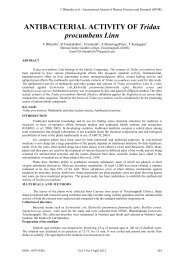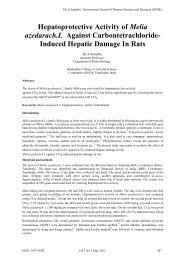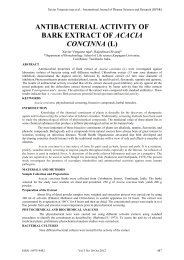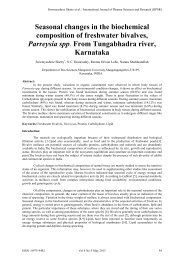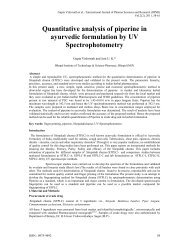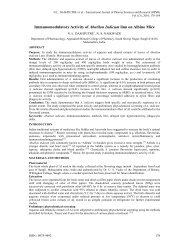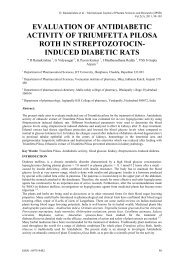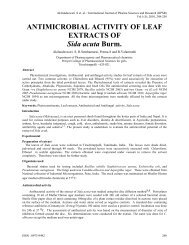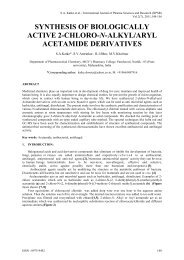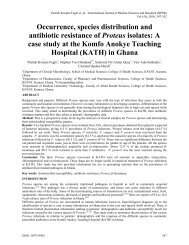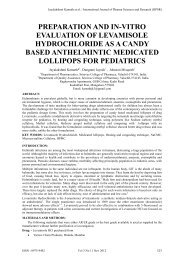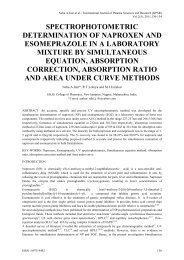Formulation, Development and In-Vitro Evaluation of Mucoadhesive ...
Formulation, Development and In-Vitro Evaluation of Mucoadhesive ...
Formulation, Development and In-Vitro Evaluation of Mucoadhesive ...
You also want an ePaper? Increase the reach of your titles
YUMPU automatically turns print PDFs into web optimized ePapers that Google loves.
Rohit Chaudhary et. al. / <strong>In</strong>ternational Journal <strong>of</strong> Pharma Sciences <strong>and</strong> Research (IJPSR)<br />
Vol.1(9), 2010, 357-365<br />
<strong>Formulation</strong>, <strong>Development</strong> <strong>and</strong> <strong>In</strong>-<strong>Vitro</strong><br />
<strong>Evaluation</strong> <strong>of</strong> <strong>Mucoadhesive</strong> Buccal Patches<br />
Of Methotrexate.<br />
Rohit Chaudhary 1 *, Md. Shamim Qureshi 2 , Jitendra Patel 3 , Uttam Prasad Panigrahi 3 , I.C.Giri 4 .<br />
1* S.D. College <strong>of</strong> Pharmacy <strong>and</strong> Vocational studies, Muzaffarnagar (UP)-251001<br />
2 Anwarul Uloom College <strong>of</strong> Pharmacy, New Mallepally, Hyderabad-500001, Andhra Pradesh, <strong>In</strong>dia.<br />
3 Department <strong>of</strong> Pharmacognosy, Navabharat <strong>In</strong>stitute <strong>of</strong> Pharmaceutical <strong>and</strong> Medical Sciences, Mangalpally,<br />
Ibrahimpatnam, RR Dist- 501510, AP, <strong>In</strong>dia.<br />
4 Dr. M.C. Saxena College <strong>of</strong> Pharmacy Lucknow (UP) 226020<br />
ABSTRACT:<br />
The goal <strong>of</strong> present investigation was to design <strong>and</strong> evaluate mucoadhesive bilayered buccal devices comprising a<br />
drug containing mucoadhesive layer <strong>and</strong> a drug free backing membrane. Bilaminatd patches composed <strong>of</strong> mixture <strong>of</strong><br />
drug (Methotrexate) <strong>and</strong> sodium alginate alone or in combination with sodium carboxy methylcellulose<br />
,Polyvinylpyrrolidine <strong>and</strong> carbopol 934 <strong>and</strong> backing membrane (Ethyl cellulose).The patches were fabricated by<br />
solvent casting technique <strong>and</strong> were evaluated for <strong>In</strong>-<strong>Vitro</strong> <strong>and</strong> Ex-Vivo drug release. The patches were evaluated for<br />
film weight uniformity, thickness, swelling index, surface pH, mucoadhesive strength <strong>and</strong> mucoadhesive time <strong>and</strong><br />
folding endurance. A combination <strong>of</strong> sodium alginate with carbopol-934 <strong>and</strong> glycerol as plasticizer gives promising<br />
results. The optimized patch exhibit an in vitro release <strong>of</strong> 82% through cellophane membrane <strong>and</strong> 70.78 % through<br />
buccal mucosa with satisfactory mucoadhesive strength <strong>and</strong> mucoadhesive time.<br />
The release kinetics <strong>of</strong> formulation also studied .The release kinetics through cellophane membrane was<br />
Higuchi while in buccal mucosa it is zero order .From Higuchi model we can say the mechanism <strong>of</strong> drug release is<br />
diffusion control .The ex vivo also fitted to Korsmayer-Peppas equation which characterize the release mechanism.<br />
The value <strong>of</strong> n is more than one so release was non Fickinian i.e. not depends upon concentration gradient.<br />
KEY WORDS: Mucoadhesion, Bilayered film, Methotrexate, Buccal patch.<br />
<strong>In</strong>troduction<br />
Amongst the various routes <strong>of</strong> drug delivery, oral route is perhaps the most preferred to the patient <strong>and</strong> the clinician<br />
alike. However, peroral admistration <strong>of</strong> drugs has disadvantages such as hepatic first pass metabolism <strong>and</strong> enzymatic<br />
degradation within the GI tract, that prohibit the oral administration <strong>of</strong> certain classes <strong>of</strong> drugs. Consequently, other<br />
absorptive mucosa is considered as potential sites for drug admistration. Transmucosal routes <strong>of</strong> drug delivery (i.e.<br />
the mucosal lining <strong>of</strong> the nasal, rectal, vaginal, ocular <strong>and</strong> oral cavity) after distinct advantages over peroral<br />
administration for systematic drug delivery. These advantages include possible by pass <strong>of</strong> first pass effect, avoidance<br />
<strong>of</strong> pre-systemic elimination within the G.I. tract, <strong>and</strong> depending on the particular drugs, a better enzymatic flora for<br />
drug absorption [1]. The potential irritation <strong>and</strong> the irreversible damage to the cillary action <strong>of</strong> the nasal dosage form<br />
as well as the large intra <strong>and</strong> inter subject variability in mucus secretion in the nasal mucosa, could significantly<br />
affect drug absorption from this site. Even though the rectal, vaginal <strong>and</strong> ocular mucosa all <strong>of</strong>fer certain advantages,<br />
the poor patient acceptability associated with these sites render them reserved for local application rather than<br />
systemic drug administration. The oral cavity on the other h<strong>and</strong> is highly acceptable by patients, the mucosa is<br />
relatively permeable with a rich blood supply, it is robust <strong>and</strong> shows short recovery times after stress or damage [2]<br />
<strong>and</strong> the virtual lack <strong>of</strong> Langerhans cells [5] makes the oral mucosa tolerant to potential allergens.<br />
The oral mucosal drug delivery systems can be localized easily <strong>and</strong> well accepted by patients [2]. The total surface<br />
<strong>of</strong> the oral cavity is about 100 cm. [7]. The mucosal membranes <strong>of</strong> the oral cavity can be divided into five regions<br />
such as the floor <strong>of</strong> the mouth (sublingual), the buccal mucosa (cheeks), the gums (gingival), palatal mucosa, <strong>and</strong> the<br />
lining <strong>of</strong> the lips. These oral mucosal regions are different from each other in terms <strong>of</strong> anatomy, permeability to<br />
ISSN : 0975-9492 357
Rohit Chaudhary et. al. / <strong>In</strong>ternational Journal <strong>of</strong> Pharma Sciences <strong>and</strong> Research (IJPSR)<br />
Vol.1(9), 2010, 357-365<br />
drug, <strong>and</strong> their ability to retain a system for a desired length <strong>of</strong> time. Although the buccal mucosa is less permeable<br />
than the sublingual mucosa <strong>and</strong> it does not yield a rapid onset <strong>of</strong> action as seen with sublingual delivery, mucosa <strong>of</strong><br />
the buccal area has an expanse <strong>of</strong> smooth <strong>and</strong> relatively immobile surface, which is suitable for placement <strong>of</strong><br />
retentive system. These characteristics make the buccal mucosa a more appropriate site for prolonged systemic<br />
delivery <strong>of</strong> drugs [8]. Methotrexate is one <strong>of</strong> the oldest <strong>and</strong> highly efficacious antineoplastic drugs; inhibit<br />
dihydr<strong>of</strong>olate reductase, blocking the conversion <strong>of</strong> dihydr<strong>of</strong>olic acid to tetrahydr<strong>of</strong>olic acid which is an essential<br />
coenzyme required for one carbon transfer reactions in denovo purine synthesis <strong>and</strong> amino acid interconversion.<br />
Methotrexate at high dose cause pancytopenia, Methotrexate also causes desquamation <strong>and</strong> bleeding <strong>of</strong> G.I.T. so an<br />
attempt was made to remove this problem. At last stage <strong>of</strong> cancer patient is unable to take dose by oral route so an<br />
attempt is made to develop an alternative route [9].<br />
Material <strong>and</strong> Methods<br />
Methotrexate was gift sample <strong>of</strong> Horizon Pharmaceutical, Muzaffarnagar, (UP). The entire all polymers were<br />
purchased from Loba chemicals Ltd. Mumbai. The backing membrane was prepared by dissolving ethyl cellulose<br />
(5%) in mixture <strong>of</strong> acetone <strong>and</strong> isopropyl alcohol (60:40). Glycerol (5%) was added as plasticizer. The plasticized<br />
ethyl cellulose solution was poured in to a Petridis on level surface <strong>and</strong> allowed to evaporate at controlled rate by<br />
covering the Petridis with funnel to avoid blistering effect on dried films [10]. Buccal patches were formulated with<br />
drug by solvent casting method. The composition was as shown in table 1. Drug was calculated on the basis <strong>of</strong> area.<br />
Drug was loaded after dispersion in 5ml phosphate buffer. Drugs was added in polymeric dispersion <strong>of</strong> buccal patch<br />
formulation with continuous stirring & poured the solution when drug was homogenously dispersed or dissolved in<br />
Petridish.<br />
Total area <strong>of</strong> Petridish was =45.2 cm 2<br />
Drug require in 2×2 cm 2<br />
So total drug loaded<br />
=10 mg<br />
=113 mg<br />
<strong>Evaluation</strong> <strong>of</strong> Buccal Patches [11]<br />
The patches were evaluated for uniformity <strong>of</strong> weight Thickness, Folding endurance, Surface pH, Swelling index,<br />
<strong>Mucoadhesive</strong> strength, <strong>Mucoadhesive</strong> Time, Drug content Uniformity, <strong>In</strong>-vitro drug release studies, Ex -vivo<br />
release, Characterization <strong>of</strong> release kinetics & Characterization <strong>of</strong> release mechanism.<br />
For evaluation <strong>of</strong> film weight three film <strong>of</strong> 2×2cm 2 formulation <strong>of</strong> each was taken & weighed individually on a<br />
digital balance <strong>of</strong> 220 gm.The result were analyzed for mean <strong>and</strong> st<strong>and</strong>ard deviation.For evaluation <strong>of</strong> thickness,<br />
three films <strong>of</strong> 2×2cm 2 each formulation was taken & the film thickness was measured by digital thickness gauze.<br />
The results were analyzed for mean <strong>and</strong> st<strong>and</strong>ard deviation. Three films <strong>of</strong> each formulation <strong>of</strong> size 2×2cm 2 were cut<br />
by using sharp blade. Folding endurance was determined by repeatedly folding a small strip <strong>of</strong> film at the same<br />
place till it broke. The number <strong>of</strong> times, the film could be folded at the same place without breaking, gave the value<br />
<strong>of</strong> folding endurance. The results were analyzed for mean <strong>and</strong> st<strong>and</strong>ard deviation. The surface pH <strong>of</strong> the patches<br />
was determined in order to investigate the possibility <strong>of</strong> any side effects, in-vivo. An acidic or alkaline pH may cause<br />
irritation to the buccal mucosa; it was our attempt to keep the surface pH as close to neutral as possible. For the<br />
determination <strong>of</strong> surface pH three patches <strong>of</strong> 2×2cm 2 <strong>of</strong> each formulation were kept in contact with 1ml <strong>of</strong> distilled<br />
water for 2hrs, in test tubes. Excess <strong>of</strong> water from the tubes was drained <strong>and</strong> the pH was noted by bringing the<br />
electrode near the surface <strong>of</strong> the formulation <strong>and</strong> allowing it to equilibrate for one min. The results were analyzed<br />
for mean <strong>and</strong> st<strong>and</strong>ard deviation.<br />
For the determination <strong>of</strong> swelling index the preweighed three patches <strong>of</strong> 2×2cm 2 <strong>of</strong> each formulation were placed in<br />
a beaker (containing 20 ml <strong>of</strong> water).After particular interval patches was removed <strong>and</strong> wiped with tissue paper <strong>and</strong><br />
weighed [12].<br />
Formula <strong>of</strong> Swelling <strong>In</strong>dex<br />
S.I = W 2 -W 1 / W 1 × 100<br />
Where-<br />
S.I. - swelling index<br />
ISSN : 0975-9492 358
Rohit Chaudhary et. al. / <strong>In</strong>ternational Journal <strong>of</strong> Pharma Sciences <strong>and</strong> Research (IJPSR)<br />
Vol.1(9), 2010, 357-365<br />
W1- weight <strong>of</strong> buccal patch before dipping into beaker<br />
W2- weight <strong>of</strong> buccal patch after dipping in beaker & wiped<br />
The strength <strong>of</strong> bond between the formulation <strong>and</strong> mucosa membrane excised from sheep buccal mucosa was<br />
determined using tensile experiments on a specially fabricated assembly like Satishbabu, et al. The sheep buccal<br />
mucosa was used as model membrane <strong>and</strong> isotonic phosphate buffer pH 7.4 was used as the moistening fluid. The<br />
sheep buccal mucosa was then stuck onto inner surface <strong>of</strong> the Petridis using suitable glue such that a mucosal<br />
surface faces upwards. Then the phosphate buffer pH 7.4 was added into Petridish such that the buffer was contacted<br />
with the mucosal membrane. Two sides <strong>of</strong> balance were made equal before study, by keeping a 5 gm weight on the<br />
left side [14]. A Petridis containing mucosal membrane was kept below the right-h<strong>and</strong> setup <strong>of</strong> the balance. The test<br />
dummy films were stuck on to lower flat side <strong>of</strong> hanging glass assembly. The surface <strong>of</strong> mucosa was blotted with<br />
whatman filter paper no 42. 2 ml <strong>of</strong> phosphate buffer pH 7.4 was added to the mucosal surface. 5 gm weight from<br />
the left pan was removed. This lowered the glass assembly along with film over the membrane with weight <strong>of</strong> 5 gm.<br />
This was kept undisturbed for 3 minute. Then the weights on the left h<strong>and</strong> side were slowly added till the patch just<br />
separated from the membrane surface. The excess weight on the left pan that is total weight minus 5 gm was taken<br />
as adhesive strength. The in-vitro mucoadhesive time was determined using Disintegration apparatus. The<br />
disintegration medium was 800 ml <strong>of</strong> phosphate buffer pH 7.4 maintained at 37±2 0 C. The segment <strong>of</strong> buccal<br />
mucosa <strong>of</strong> sheep sere glued to the surface <strong>of</strong> glass slab, which was then vertically attached to the apparatus. Three<br />
mucoadhesive film <strong>of</strong> each formulation were hydrated on one surface using pH 7.4 Phosphate buffer. And the<br />
hydrated surface was brought into contact with the mucosal membrane & allowed the apparatus to move up & down.<br />
The time required for complete detachment <strong>of</strong> the film from surface was recorded. The results were analyzed for<br />
mean <strong>and</strong> st<strong>and</strong>ard deviation.Three films <strong>of</strong> 2×2cm 2 <strong>of</strong> each formulation were taken in separate 10ml volumetric<br />
flask. 10 ml <strong>of</strong> phosphate buffer saline ph 7.4 was added <strong>and</strong> continuously stirred for 24 hr. The solution were<br />
filtered, diluted suitably <strong>and</strong> analyzed at 303 nm in a U.V. spectrometer. The average <strong>of</strong> drug contents <strong>of</strong> three<br />
patches was taken as final reading. The results were analyzed for mean <strong>and</strong> st<strong>and</strong>ard deviation. <strong>In</strong>-vitro release<br />
study, cellophane membrane was used as a barrier membrane. Phosphate buffer pH 7.4 used as a medium. The<br />
cellophane membrane was soaked for 24 hours in Phosphate buffer. The patches were evaluated for drug release<br />
using Keshary-Chain type diffusion cells. Cellophane membrane was mounted between the donor <strong>and</strong> receptors<br />
compartments. The patch was placed on the cellophane membrane. The diffusion cell was placed in a water bath<br />
maintained at 37±2 0 C.The receptor compartment was filled with (50 ml capacity) phosphate buffer pH 7.4 <strong>and</strong><br />
hydrodynamics was maintained by stirring with a magnetic bead at 100 rpm. the 5 ml sample was withdrawn <strong>and</strong><br />
replaced with 5 ml fresh medium to maintain the sink condition. The sample was analyzed in U.V.<br />
spectrophotometer at 303 nm wavelength. [4] Ex-vivo release study, sheep buccal mucosa was used as a barrier<br />
membrane. Phosphate buffer pH 7.4 used as a medium. The buccal mucosa was mounted between the donor <strong>and</strong><br />
receptors compartments. The patches were evaluated for drug release using Keshary-Chain type diffusion cells.<br />
Cellophane membrane was mounted between the donor <strong>and</strong> receptors compartments. The patch was placed on the<br />
cellophane membrane. The diffusion cell was placed in a water bath maintained at 37 0 C.The receptor compartment<br />
was filled with (50 ml capacity) phosphate buffer pH 7.4 <strong>and</strong> hydrodynamics was maintained by stirring with a<br />
magnetic bead at 100 rpm. The 5 ml sample was withdrawn <strong>and</strong> replaced with 5 ml fresh medium to maintain the<br />
sink condition. The sample was analyzed in U.V. spectrophotometer at 303 nm wavelength [13]. The in-vitro <strong>and</strong><br />
ex-vivo release data were fitted into different kinetics like zero order, First order <strong>and</strong> Higuchi kinetics <strong>and</strong> R 2 values<br />
were calculated. The ex-vivo release data were fitted into Korsmeyer-Peppas model <strong>and</strong> an n value was calculated by<br />
plotting Log % cumulative drug release vs. Log time.<br />
Result <strong>and</strong> Discussion<br />
All the formulations (F1, F2, F3 <strong>and</strong> F4) show uniformity in weights. The average weights <strong>of</strong> different formulations<br />
were found in the range 241 to 251 mg. The formulation F3 was having minimum average weight while the<br />
formulation F4 was having maximum average weight. Results are shown as Mean ± st<strong>and</strong>ard deviation in table<br />
2.The film thicknesses were observed uniform. The thickness was observed in the range 0.40 to 0.53 mm. Result are<br />
shown as Mean ± st<strong>and</strong>ard deviation. (Table 3).The folding endurance was measured manually, by folding the film<br />
repeatedly at a point till they broke. The breaking time was considered as the end point. The maximum average<br />
folding was found to be highest for formulation F4 <strong>and</strong> lowest for F1. The folding endurance was found optimum<br />
<strong>and</strong> the patches exhibited good physical <strong>and</strong> mechanical properties. It was found that folding endurance <strong>of</strong> sodium<br />
alginate patches was increased by the addition <strong>of</strong> polymer in order Carbopol934 > Polyvinylpyrrolidine ><br />
Sodiumcarboxy methylcellulose > sodium alginate. Results are shown as mean ± st<strong>and</strong>ard deviation<br />
table4.Considering the fact that acidic or alkaline pH may cause irritation to the buccal mucosa .The surface pH <strong>of</strong><br />
ISSN : 0975-9492 359
Rohit Chaudhary et. al. / <strong>In</strong>ternational Journal <strong>of</strong> Pharma Sciences <strong>and</strong> Research (IJPSR)<br />
Vol.1(9), 2010, 357-365<br />
the buccal films was determined to optimize both drug permeation <strong>and</strong> mucoadhesion. Attempts were made to keep<br />
the surface pH as close as salivary pH. pH <strong>of</strong> all the formulations were within the range <strong>of</strong> salivary pH. No<br />
significant difference was found in surface pH <strong>of</strong> different formulations. Results are shown as mean ± st<strong>and</strong>ard<br />
deviation table 5. The comparative percentage swelling <strong>of</strong> various formulations was in order <strong>of</strong> F1>F3>F2>F4<br />
percentage swelling <strong>of</strong> formulation F1 is highest because it contain Sodium carboxy methyl cellulose. Sodium<br />
carboxy methyl cellulose showed high % swelling because <strong>of</strong> the presence <strong>of</strong> more hydroxyl group. <strong>Formulation</strong> F4<br />
showed less swelling index. Results are shown as mean ± st<strong>and</strong>ard deviation table 6.The mucoadhesive strength<br />
shown by all formulation was good. The formulation F3 showed maximum mucoadhesive strength while<br />
formulation F2 shows minimum mucoadhesive strength. The results are shown as mean ± st<strong>and</strong>ard deviation table 7.<br />
All formulations were show satisfactory mucoadhesive strength. <strong>Formulation</strong> F4 show maximum mucoadhesive<br />
time while formulation F2 shows minimum mucoadhesive time. The results are shown as mean ± st<strong>and</strong>ard deviation<br />
table 8.Drug content in all formulations were uniform with a range <strong>of</strong> 90.2% to 91.9%. This indicates that the drug<br />
was dispersed uniformly throughout the patches. The results are shown as mean ± st<strong>and</strong>ard deviation table 9. The<br />
release rate from different formulations through cellophane membrane shows that, release <strong>of</strong> drug from these<br />
patches exhibit two phases. There is a initial burst effect is followed by the completion <strong>of</strong> a stable gel layer which in<br />
turn, controls the release <strong>of</strong> drug from the delivery system. As it can be seen in table 10 <strong>and</strong> figure 1. The<br />
formulation with only sodium alginate yielded a faster initial burst effect. While the formulation with carbopol-934,<br />
PVP <strong>and</strong> sodium CMC showed sustained release. This indicates that increase in the viscosity <strong>of</strong> formulation<br />
decrease the release rate <strong>of</strong> methotrexate. The formulation F3 is the optimized formulation because it shows good<br />
swelling index convient residence time as well as promising drug release pattern, swelling index. <strong>Formulation</strong> F3<br />
was selected for Ex-vivo release study. The formulation F4 was not selected because formulation did not control the<br />
release <strong>and</strong> it release the methotrexate as immediate release formulation. The cumulative drug release <strong>of</strong> the<br />
formulation containing sodium alginate with a secondary polymer was found in order <strong>of</strong> Sodium alginate ><br />
carbopol-934 > Sodium Carboxymethylcellulose > polyvinylpyrroliidine at the end <strong>of</strong> 8 hours. The formulation F3<br />
shows drug permeation through sheep buccal mucosa up to 8 hours was 70.78%. The results are shown in table<br />
11.The release kinetics <strong>of</strong> methotrexate through buccal mucosa was studied. The in- vitro drug release data was fit<br />
into first order, zero order <strong>and</strong> Higuchi release kinetics as shown in figure 2. The formulation F3 shows zero order<br />
release kinetics because the R 2 value <strong>of</strong> zero order was closer to 1 that is 0.971 <strong>and</strong> highest from all. To examine the<br />
release mechanism <strong>of</strong> methotrexate from the buccal patches the result were analyzed according to the following<br />
equation<br />
M t / M ∞ =K t n<br />
Where - M t / M ∞ is the fractional drug release at time t,<br />
K is a kinetic constant incorporating structural <strong>and</strong> geometric characteristic <strong>of</strong> the drug / polymer system [device],n<br />
is the diffusion exponent that characterizes the mechanism <strong>of</strong> drug release. <strong>In</strong> this formulation the value <strong>of</strong> n is 1.279<br />
which is greater than 1. So in this formulation the release is non Fickinian that is not depending upon the<br />
concentration gradient. The value <strong>of</strong> n is more than 1 so this is supra case II transport.<br />
References:<br />
[1] Shojaei AH et al., 1998. Buccal mucosa as a route for systemic drug delivery: A Review, J Pharm.Pharmaceut Sci. 1981,(1):15-30.<br />
[2] Rathbone MJ, Hadgraft J. Absorption <strong>of</strong> drugs from the human oral cavity. <strong>In</strong>t J Pharm.1991, 74:9-24.<br />
[3] Devries ME , Bodde HE , verhoef JC , Junginger HE . <strong>Development</strong>s in buccal drug delivery. Crit. Rev. Ther Drug Carr Sys. 1991,8: 271-<br />
303.<br />
[4] Squier CA. The permeability <strong>of</strong> oral mucosa. Crit.Rev. Oral Biol Med.1991,2:13-32.<br />
[5] Bodde HE Devries, ME Junginger HE. <strong>Mucoadhesive</strong> polymers for the buccal delivery <strong>of</strong> peptides structure- adhesiveness relationships. J<br />
control Rel.1990, 13: 225-231.<br />
[6] Rathbone MJ, Drummond B, Tucker I. Oral cavity as a site for systemic drug delivery. Adv Drug Del Rev.1994, 13: 1-22.<br />
[7] Hoogstraate AJ, Verhoef JC, Tuk B, Pijpers A, et al. Buccal delivery <strong>of</strong> fluorescein isotjiocyanate-dextran 4400 <strong>and</strong> the peptide drug<br />
buserelin with glycodeoxycholate as an absorption enhancer in pigs. J. Control Rel.1996, 41: 77-84.<br />
[8] Shojae AH et al., 1998. Buccal mucosa as a route for systemic drug delivery. A Review, J Pharm Pharmaceut Sci.1998, 1(2): 66-73.<br />
[9] Tripathi KD. “Essentials Medical pharmacology” Jaypee Brothers Medical Publishers (P) Ltd. 4th Edition 1999, 829-830.<br />
[10] Satishbabu BK et al., 2008. Prepration <strong>and</strong> evaluation <strong>of</strong> buccoadhesive films <strong>of</strong> Atenolol. <strong>In</strong>dian J Pharm Sci. 2008, 70(2): 175-179.<br />
[11] Semalty et al., 2008. <strong>Formulation</strong> <strong>and</strong> characterization <strong>of</strong> <strong>Mucoadhesive</strong> buccal films <strong>of</strong> Glipizide. <strong>In</strong>dian J Pharm Sci. 2008, 70(1): 43-48.<br />
[12] Wells JI, Bhatt DA, Khan KA. Improved wet massed tableting using plasticized binder. J Pharmacol.1982, 46: 34-46.<br />
[13] P<strong>and</strong>it JK et al., 2001. Systemic absorption <strong>of</strong> Propranolol hydrochloride from buccoadhesive films. <strong>In</strong>dian J Pharm Sci. 2001, 63(6): 473-<br />
480.<br />
[14] Satishbabu et al., 2008. Prepration <strong>and</strong> evaluation <strong>of</strong> buccoadhesive Films <strong>of</strong> Atenolol. <strong>In</strong>dian J Pharm Sci. 2008, 70(2): 175-179.<br />
ISSN : 0975-9492 360
Rohit Chaudhary et. al. / <strong>In</strong>ternational Journal <strong>of</strong> Pharma Sciences <strong>and</strong> Research (IJPSR)<br />
Vol.1(9), 2010, 357-365<br />
Table: 1 Buccal patches formulation with drug.<br />
<strong>In</strong>gredients Units F1 F2 F3 F4<br />
Drug (mg) 113 113 113 113<br />
Sodium alginate (mg) 800 800 800 1000<br />
Sodium c.m.c. (mg) 200<br />
P.V.P. (mg) 200<br />
Carbopol 934 (mg) 200<br />
Glycerol % 10 10 10 10<br />
D.water ml 30 30 30 30<br />
Sodium c.m.c.: sodium carboxy methyl cellulose, P.V.P.: polyvinylpyrollidone, D.water: distilled water,<br />
Table 2: Patches weight <strong>of</strong> all formulations<br />
<strong>Formulation</strong>s<br />
Wt.<strong>of</strong> I st<br />
(mg)<br />
Wt. <strong>of</strong> II ND<br />
(mg)<br />
Wt. <strong>of</strong> III rd<br />
(mg)<br />
Mean ±S.D.<br />
(mg)<br />
F1 250 253 251 247.67±1.52<br />
F2 241 244 245 243.33±2.08<br />
F3 239 242 245 242.00±3.0<br />
F4 250 249 247 248.67±1.53<br />
S.D.: st<strong>and</strong>arad deviation, Wt. : weight,<br />
Table3: Thickness <strong>of</strong> all formulations<br />
<strong>Formulation</strong>s I st (mm) II nd (mm) III rd (mm) Mean ±S.D. (mm)<br />
F1 0.49 0.44 0.51 0.48±0.036<br />
F2 0.46 0.49 0.43 0.46±0.03<br />
F3 0.42 0.40 0.46 0.43±0.031<br />
F4 0.53 0.47 0.48 0.49±.032<br />
S.D.: st<strong>and</strong>arad deviations<br />
Table 4: Folding endurance <strong>of</strong> all formulations<br />
<strong>Formulation</strong>s I st no. II nd no. III rd no. Mean ±S.D.<br />
F1 161 165 163 163±2.0<br />
F2 172 170 174 172±2.0<br />
F3 178 177 180 178±1.53<br />
F4 185 189 182 185±3.51<br />
S.D.:st<strong>and</strong>arad deviations<br />
Table 5: Surface ph <strong>of</strong> all formulations<br />
<strong>Formulation</strong>s I ST II ND III RD Mean ±S.D<br />
F1 6.4 6.8 6.8 6.7±0.23<br />
F2 6.2 6.5 6.7 6.5±0.25<br />
F3 6.2 6.1 6.4 6.2±0.15<br />
F4 7.0 6.7 6.9 6.9±0.15<br />
S.D.:st<strong>and</strong>arad deviations<br />
ISSN : 0975-9492 361
Rohit Chaudhary et. al. / <strong>In</strong>ternational Journal <strong>of</strong> Pharma Sciences <strong>and</strong> Research (IJPSR)<br />
Vol.1(9), 2010, 357-365<br />
Table 6: Swelling indexes <strong>of</strong> all formulations.<br />
Time<br />
(minutes)<br />
S.I.<strong>of</strong> F1<br />
(%)<br />
S.I.<strong>of</strong> F2<br />
( %)<br />
.I.<strong>of</strong> F3<br />
( %)<br />
S.I.<strong>of</strong> F4<br />
( %)<br />
5 4.12 3.40 3.87 3.80<br />
10 7.21 6.47 5.91 5.19<br />
15 9.86 9.07 7.94 6.57<br />
20 13.49 11.47 11.58 11.41<br />
25 16.33 13.87 14.88 13.00<br />
30 19.51 16.10 17.00 16.76<br />
35 21.64 18.5 19.67 18.41<br />
40 24.54 20.82 21.92 20.92<br />
45 26.82 23.13 23.41 23.00<br />
50 27.22 25.49 25.58 24.77<br />
55 29.51 26.42 27.41 25.41<br />
60 31.24 27.49 29.81 27.38<br />
120 58.89 52.44 53.91 51.60<br />
S.D.: st<strong>and</strong>arad deviations, S.I. : swelling index<br />
Table 7: <strong>Mucoadhesive</strong> strength <strong>of</strong> all formulation<br />
S.N FORMULATIONS I ST II ND III RD Mean ±S.D.<br />
(s) (s) (s) (s)<br />
1 F1 237 232 190 220±25.81<br />
2 F2 220 229 162 204±29.53<br />
3 F3 222 230 240 230.66±9.01<br />
4 F4 201 230 247 226±23.26<br />
S.D.: st<strong>and</strong>arad deviations.<br />
Table 8: <strong>Mucoadhesive</strong> time<strong>of</strong> all formulations<br />
S.N FORMULATIONS I ST<br />
(s)<br />
II ND<br />
(s)<br />
III RD<br />
(s)<br />
Mean ±S.D.<br />
(s)<br />
1 F1 237 232 190 220±25.81<br />
2 F2 220 229 162 204±29.53<br />
3 F3 222 230 240 230.66±9.01<br />
4 F4 201 230 247 226±23.26<br />
S.D.: st<strong>and</strong>arad deviations,S : second<br />
ISSN : 0975-9492 362
Rohit Chaudhary et. al. / <strong>In</strong>ternational Journal <strong>of</strong> Pharma Sciences <strong>and</strong> Research (IJPSR)<br />
Vol.1(9), 2010, 357-365<br />
Table 9: Drug contents <strong>of</strong> all formulations.<br />
<strong>Formulation</strong>s I ST<br />
Mg<br />
II ND<br />
Mg<br />
III RD Mean<br />
±S.D.mg<br />
Drug content<br />
%<br />
F1 9.12 8.91 9.02 9.02±0.11 90.2<br />
F2 9.50 9.07 9.00 9.19±0.27 91.9<br />
F3 9.43 8.84 9.07 9.11±0.30 91.1<br />
F4 9.49 9.01 9.77 9.11±0.38 91.1<br />
S.D.: st<strong>and</strong>arad deviations<br />
Table 10: in vitro drug releases through cellophane membrane.<br />
Time<br />
(Hours)<br />
F1<br />
%<br />
Cumulative<br />
Drug Release<br />
F2<br />
%<br />
Cumulative<br />
Drug Release<br />
F3<br />
%<br />
Cumulative<br />
Drug Release<br />
F4<br />
%<br />
Cumulative<br />
Drug Release<br />
1 6.11 5.97 20.72 49.53<br />
2 17.94 9.07 39.57 97.06<br />
3 30.25 12.91 53.61<br />
4 40.35 24.22 54.64<br />
5 52.96 36.84 65.48<br />
6 58.42 43.61 69.51<br />
7 61.31 46.29 74.09<br />
8 66.74 53.91 82.97<br />
Table 11: Drug release through sheep buccal mucosa <strong>of</strong> formulation f3<br />
Time in<br />
(h)<br />
SQRT<br />
% Cumulative Log %<br />
Drug Cumulative<br />
Release. Drug<br />
Release.<br />
%<br />
Drug<br />
remaining<br />
Log %<br />
drug<br />
remaining<br />
1 1 6.22 0.7938 93.78 1.9721<br />
2 1.4142 10.41 1.0175 89.59 1.9523<br />
3 1.7321 18.28 1.2620 81.72 1.9123<br />
4 2.0 31.39 1.4968 68.61 1.8364<br />
5 2.2361 49.42 1.6939 50.58 1.7040<br />
6 2.4495 57.49 1.7596 42.51 1.6285<br />
8 2.8284 70.78 1.8499 29.22 1.4657<br />
ISSN : 0975-9492 363
Rohit Chaudhary et. al. / <strong>In</strong>ternational Journal <strong>of</strong> Pharma Sciences <strong>and</strong> Research (IJPSR)<br />
Vol.1(9), 2010, 357-365<br />
% cumulative drug release<br />
120<br />
100<br />
80<br />
60<br />
40<br />
20<br />
0<br />
0 2 4 6 8 10<br />
Time (h)<br />
Fig.1: Diffusion pr<strong>of</strong>iles <strong>of</strong> methotrexate from buccal patch through cellophane membrane<br />
Diffusion pr<strong>of</strong>iles <strong>of</strong> methotrexate from various buccal patches containing various concentrations <strong>of</strong> bioadhesive polymer<br />
through cellophane membrane, (-×-) F4, (-▲-) F3, (--) F1, (-■-) F2.<br />
% cumulative drug release<br />
80<br />
70<br />
60<br />
50<br />
40<br />
30<br />
20<br />
10<br />
0<br />
y = 10.182x ‐ 7.3255<br />
R² = 0.9715<br />
0 2 4 6 8 10<br />
Time (h)<br />
Fig. 2: Zero order release kinetics <strong>of</strong> formulation F3 through sheep buccal mucosa<br />
ISSN : 0975-9492 364
Rohit Chaudhary et. al. / <strong>In</strong>ternational Journal <strong>of</strong> Pharma Sciences <strong>and</strong> Research (IJPSR)<br />
Vol.1(9), 2010, 357-365<br />
Log % cumulative drug release<br />
2<br />
1.5<br />
1<br />
0.5<br />
0<br />
0 0.2 0.4 0.6 0.8 1<br />
Log time<br />
Fig.3: Release <strong>of</strong> formulation F3 through Sheep buccal mucosa data fitted to Korsmeyer-Peppas.<br />
ISSN : 0975-9492 365



